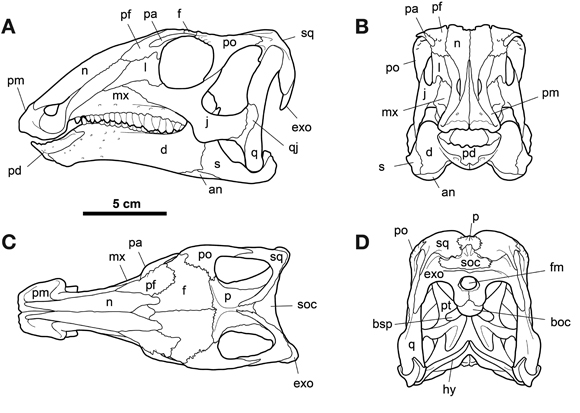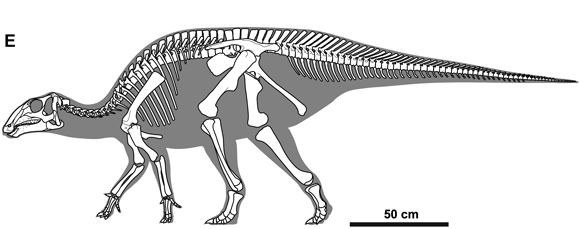Gobihadros mongoliensis – A Newly Described Hadrosauroid from Mongolia
Scientists have described a new species of basal hadrosauroid from the Baynshire Formation of the central and eastern Gobi Desert (Mongolia). It has been named Gobihadros mongoliensis. At approximately three metres long, this cow-sized, ornithischian may not be the most impressive dinosaur to have been found, but its discovery is significant for vertebrate palaeontologists. G. mongoliensis is the first non-hadrosaurid hadrosauroid from the Late Cretaceous of central Asia known from an almost complete, articulated skull and postcranial material.
A Skeletal Reconstruction of Gobihadros mongoliensis
Picture credit: PLOS One
Writing in the on-line academic journal “PLOS One”, the researchers David Evans (Royal Ontario Museum, Ontario, Canada), Khishigjav Tsogtbaatar (Mongolian Academy of Sciences), David Weishampel (John Hopkins University, Maryland, USA) and Mahito Watabe (Osaka City University, Japan), have concluded that Gobihadros is similar to Bactrosaurus johnsoni from eastern China and Gilmoreosaurus mongoliensis from the Iren Nor region of Inner Mongolia.
Outside of the Hadrosauridae Family
A phylogenetic assessment places Gobihadros outside of the Hadrosauridae, the family of dinosaurs commonly referred to as the duck-billed dinosaurs. Gobihadros most certainly had a broad beak, very typical of a duck-billed dinosaur, but it has been classified as a basal member of the Hadrosauroidea, essentially the next classification bracket up from the Hadrosauridae, encompassing all the duck-billed dinosaurs and all dinosaurs more closely related to them than to Iguanodon.
Views of the Skull and Jaw Bones of Gobihadros mongoliensis

Picture credit: PLOS One
Gobihadros mongoliensis from the Baynshire Formation
The fossil material was collected over a period of several years from the sandstone and mudstone deposits from a number of sites associated with the Baynshire Formation. The dinosaur was described from two superbly preserved specimens, a complete and uncrushed skull (MPC-D100/763) and the holotype, which consists of an almost complete skull and postcranial skeleton found largely in an articulated state. Although, the exact date of the Baynshire Formation remains open to debate, recent studies place the sediments in the early Late Cretaceous (Cenomanian-Santonian faunal stages).
Line Drawings of the Skull and Jaws of G. mongoliensis

Picture credit: PLOS One
Helping Scientists to Understand an Evolutionary Transition
The exquisite nature of the fossil preservation and its completeness has provided palaeontologists with one of the most detailed anatomical records of a hadrosauroid. New information has been compiled documenting the evolutionary transition of the Hadrosauroidea towards the Hadrosauridae. In addition, comparison with the fossil remains of much younger hadrosaurids from the Late Cretaceous of Asia (Maastrichtian faunal stage), such as Saurolophus angustirostris, Kerberosaurus manakini, Wulagasaurus dongi and Kundurosaurus nagornyi suggests that later Asian hadrosaurids migrated into Asia from North America, rather than sharing a common Asian ancestor with Gobihadros mongoliensis.
The scientific paper: “A New Hadrosauroid (Dinosauria: Ornithopoda) from the Late Cretaceous Baynshire Formation of the Gobi Desert (Mongolia)” by Khishigjav Tsogtbaatar, David B. Weishampel, David C. Evans and Mahito Watabe published in PLOS One.
Visit the Everything Dinosaur website: Everything Dinosaur.







Leave A Comment